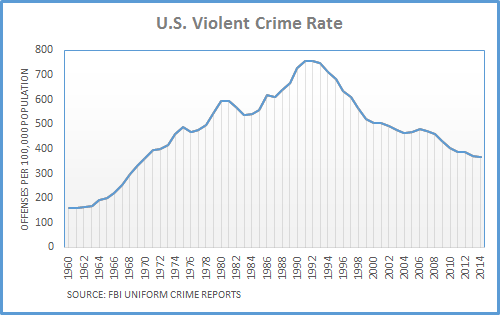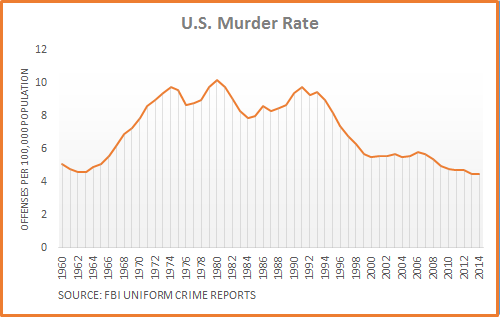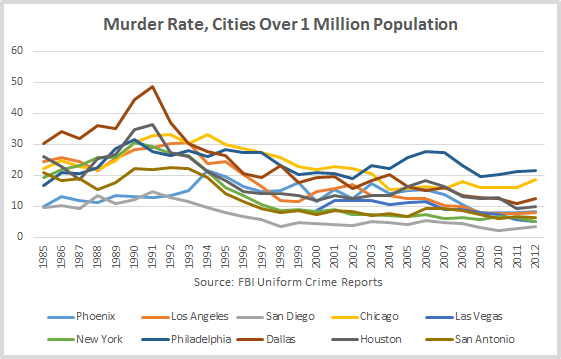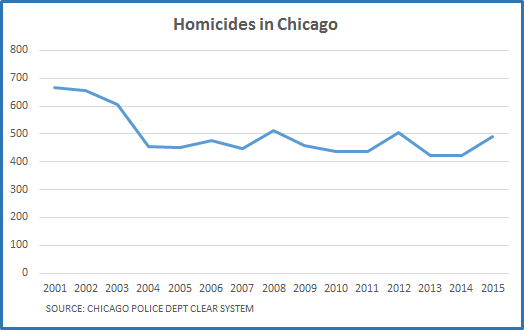President Barack Obama said there have been “huge drops in the murder rates” in cities like New York, Los Angeles and Dallas. Republican presidential candidate Donald Trump said “violent crime has increased in cities across America.” Which is it? We’ll score this one for Obama.
The long-term trend is a decline, not only in the murder rates per population, but the total number of murders in the cities Obama mentioned, and nationwide. The same goes for violent crime. Trump was referring to a recent year-over-year increase in murders in some cities.
For example, the number of murders in Dallas peaked at 500 in 1991, but dropped to nearly half that (231) in 2000, according to data from the FBI’s Uniform Crime Reporting Statistics, which is based on voluntary reporting by local police departments. By 2012, the number had dropped further, to 154. That’s not adjusted for population — it’s the sheer numbers of murders and nonnegligent manslaughter reported.
So, the number of murders in Dallas went from 500 in 1991 to 154 in 2012, a decrease of 70 percent. The murder rate, offenses per 100,000 in population, dropped from 48.6 to 12.4 in that same time frame, a 74 percent decrease.
But Trump pointed to a New York Times story on an uptick in 2015 in the number of murders in several cities, including Dallas, as compared with 2014. The Times report showed a 17 percent increase in murders (an increase of 12 murders) in Dallas for January through August 2015 compared with the same time period for 2014.
Indeed, the Dallas Morning News later reported that the total for all of 2015 was a 17 percent increase over the previous year, but noted 2014’s number of murders (116) had been a “historic low” and the murder rate for 2015, according to city officials, was “the city’s fourth-lowest since Dallas police started counting in 1930.”
As criminology and statistics experts told us, we can’t discern a trend from a few years of data.
Both politicians made their claims days after the July 7 shooting in Dallas, in which five law enforcement officers were killed by a sniper who told police he was targeting white officers. This came after police in Minnesota and Louisiana had shot and killed two black men earlier that week.
In a July 9 press conference in Poland after a NATO summit, Obama said:
Obama, July 9: Now, when it comes to crime, generally, I think it’s just important to keep in mind that our crime rate today is substantially lower than it was five years ago, 10 years ago, 20 years ago, 30 years ago. Over the last four or five years, during the course of my presidency, violent crime in the United States is the lowest it’s been since probably the 1960s, maybe before the early 1960s. There’s been an incredible drop in violent crime.
So that doesn’t lessen, I think, people’s understandable fears if they see a video clip of somebody getting killed. But it is important to keep in perspective that in places like New York, or Los Angeles, or Dallas, you’ve seen huge drops in the murder rates. And that’s a testimony to smarter policing, and there are a range of other factors that have contributed to that.
Violent crime has declined over the last five, 10, 20, 30 years, as Obama said, but he went too far in claiming that it’s “the lowest it’s been since probably the 1960s.”
As this graph of violent crime rates for the nation shows, the rate is lower than it has been since 1970. And the rate has been on a steady decline since it peaked at 758.2 in 1991. It was less than half that, 365.5 in 2014. But it was lower in the 1960s than it has been in recent years. (The FBI describes its data as “estimated,” and as we mentioned it comes from voluntary reports from local law enforcement agencies.)
The murder and nonnegligent manslaughter rate nationwide, at 4.5 in 2014, was at its lowest point since at least the early 1960s, when the rate dipped as low as 4.6. (Note the numbers do not include lives lost in the Sept. 11, 2001, terrorist attacks.):
Trump made his claim in a July 11 speech in Virginia Beach.
Trump, July 11: We must discuss, as well, the ongoing catastrophe of crime in our inner cities. Our inner cities are rife with crime. According to the Chicago Tribune, there has already been more than 2,000, 2,000 shooting victims in Chicago alone this year. This epidemic of violence destroys lives, destroys communities, and destroys opportunity for young Americans. Violent crime has increased in cities across America. The New York Times described “the startling rise in murders,” in our major cities.
Trump accurately quotes both newspapers, and an annotated version of his prepared remarks includes footnotes and links to both news stories. The Tribune has chronicled the number of shooting victims, and its 2016 total as of July 12 — 2,110 victims — is outpacing the total for 2015 so far this year. (Note that’s not deaths, but shootings.)
And in an August 31, 2015, article, the New York Times said: “Cities across the nation are seeing a startling rise in murders after years of declines.” But it’s important to note that the story was about an increase in some cities between the first eight months of 2014 and the same time period of 2015, not a years-long trend.
Murders in Major Cities
The Times said in its 2015 story that 35 cities had reported increases in murder rates and/or violent crime, according to city police departments, and law enforcement officials were taking the issue seriously. But for cities including New York and Chicago, the Times reported, the increase came after 2014 numbers that were “the lowest in decades.”
This year the Times ran another story in May on increases in homicides in some cities, and decreases in others, for the first three months of 2016 compared with the first three months of 2015.
New York Times, May 13, 2016: Data released Friday by the Major Cities Chiefs Police Association, based on reports from more than 60 cities, showed notable increases in murders in about two dozen cities in the first three months of the year compared to last year and a 9 percent increase nationwide. But nearly 40 cities showed a decline or remained essentially flat.
That data demonstrated how it can be difficult to discern a trend from such small snapshots in time. For instance, the Times reported a 9 percent increase for New York City between 2014 and 2015, but the city is now showing a 25 percent decrease for the 2015 to 2016 time periods.
And while Milwaukee saw a 70 percent increase for the 2014 to 2015 dates, it had experienced a 35 percent decrease for 2015 to 2016, through early May.
That’s not to say that some cities — like Chicago, Los Angeles and Dallas — weren’t still reporting upticks for 2016.
Criminologists, though, say it’s too soon to draw conclusions. “Snapshots are not trends. And two or three years of data are far too few to establish a trend,” Richard A. Berk, professor of criminology and statistics at the University of Pennsylvania’s Wharton School, told us in an email.
Darrel Stephens, executive director of the Major Cities Chiefs Police Association, also told us it was “too soon to talk about trends.” Stephens wrote in an email to FactCheck.org: “We have seen a spike in the past year in some large cities (particularly in five or six) — something we should be concerned about to be sure but not a trend or even close to 20 years ago.”
Berk noted that murder is a small fraction of violent crime overall (that’s apparent in the above crime rate charts), and the murder increases in recent years have been in a few cities. It’s difficult to know what is causing the increases there, he said. “In LA, for example, the number of shootings has been flat but the number of homicides has jumped,” Berk said. “Are the bad guys becoming better marksmen?”
And the increases are normally concentrated in certain areas of those cities. “Crime like politics is local,” Berk said. “[T]here are not crime spike in cities, there are crime spikes in certain neighborhoods in those cities.”
To take a longer view of murders in major cities, we compiled the FBI city-specific data, which are available through 2012, and more recent 2015 numbers reported by police departments to the Major Cities Chiefs Police Association for the cities Obama and Trump mentioned, as well as others highlighted in the Times reports. Every city shows a “huge drop,” as Obama said, from the early 1990s, and mixed movement from 2012 to 2015.
We also looked at FBI data for the murder and nonnegligent manslaughter rates for police agencies serving cities with more than 1 million in population. Those figures, too, show a decline since peaking in the 1990s:
The Situation in Chicago
Trump pinpointed Chicago again in a July 12 interview on Fox News’ “The O’Reilly Factor.” But he exaggerated the number of murders that have occurred in recent years.
Trump, July 12: I can tell you that I’m sitting in Chicago where we’ve had almost 5,000 killings, deaths, from the time [Obama] became president and you don’t hear too much about it. And you know, you see what’s going on now, and by the way getting worse and worse and worse.
Trump used the same figure in a July 12 speech in Westfield, Indiana.
Four days earlier, Fox News’ Sean Hannity had cited a much lower number — 3,459 — as the number of murders in Chicago during Obama’s time in office. Hannity had cited the Chicago Police Department and Chicago Tribune as the source. We reached a similar number — 3,506 homicides — since 2009, using the Chicago Police Department’s CLEAR (Citizen Law Enforcement Analysis and Reporting) system, which includes data from 2001 through present, minus the most recent seven days.
That’s still a sizable number, but not 5,000. More important is what the number means in context. Chicago, like the rest of the country, has seen a decrease over the last several decades in the number of homicides, and the murder rate.
One last chart: We’ll look at the number of homicides since 2001, according to the Chicago Police Department’s CLEAR system, which we found to have very similar numbers but not exact matches to the FBI Uniform Crime Reports figures.
Over those 15 years, the number of homicides has dropped from more than 600 a year in the early 2000s to just under 500 in 2015. The yearly number has fluctuated since Obama took office in 2009 and topped 500 once, in 2012.
Chicago has often been singled out for the number of murders, but other cities have a higher murder rate, adjusted for population. As we wrote on this topic earlier this year, the city ranked 35th in 2014 in terms of its murder rate among cities with a population of 100,000 or more. The Pew Research Center reviewed FBI data from 1985 to 2012 and concluded in its headline that Chicago was “nowhere near U.S. ‘murder capital'” after adjusting the raw numbers for population.
— Lori Robertson, with Jenna Wang and Zachary Gross
https://www.sharethefacts.co/share/c31a3021-ccce-45df-bb45-05769710557a
https://www.sharethefacts.co/share/af8e0457-0409-4fe1-8ecb-721c8d2d3bd4




